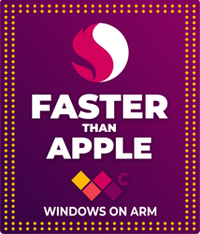
Windows on Arm | #FasterThanApple
All-new Snapdragon X Elite Arm processors from Qualcomm beat Apple's M3 chip in performance benchmarks and rank dead even with the Apple M3 Pro. The landscape of portable PCs is about to change as Windows on Arm becomes faster than Apple.
Quick answer: There is no official confirmation that Qualcomm will create additional Snapdragon X SoCs beyond what has already been announced for the platform. However, with the announcement of the more affordable Snapdragon X Plus, another, more powerful platform beyond the Snapdragon X Elite is not entirely ruled out. An Oryon CPU with over 12 cores and higher clock speeds would help Qualcomm compete with Apple's M-series ARM chips.
A quick look at the Snapdragon X platform

Qualcomm's Snapdragon X platform is a series of Systems-on-Chip (SoC) that is expected to significantly shake up the Windows on Arm landscape. The company has announced two platforms—the Snapdragon X Elite and Snapdragon X Plus—with a total of four chips between them.
The more powerful Snapdragon X Elite was first introduced in October 2023, while the more affordable Snapdragon X Plus was unveiled on April 24, 2024. The X Plus announcement clarified the X Elite's chip layout; Qualcomm has three different SKUs for the X Elite, which I discuss below. The Snapdragon X Plus platform has one chip.
These SoCs consist of an ARM64 Oryon processor (CPU), Adreno integrated graphics (GPU), and a Neural Processing Unit (NPU) for AI acceleration. All SoCs offer 5G and Wi-Fi 7 connectivity, support for three concurrent 4K displays at a 60Hz refresh rate, USB4 connectivity (Intel's Thunderbolt understandably won't be included), and AV1 decoding and encoding for 4K HDR video. The SoCs also contain a "Micro NPU" for always-enabled human presence detection.
Qualcomm Snapdragon X Elite vs. X Plus

The Snapdragon X Elite platform contains three different chips (aka SKUs), each with a 12-core CPU, 42MB cache, and 45 TOPS NPU. The most powerful X1E-84-100 chip has a multithread 3.8GHz clock speed and 4.2GHz dual-core boost clock, as well as a GPU with 4.6 TFLOPs of performance.
Next in line is the X Elite (X1E-80-100), which has a 3.4GHz multithread clock, 4.0GHz dual-core boost clock, and 3.8 TFLOPs GPU. Finally, the X Elite (X1E-78-100) is nearly identical to the X1E-80-100, except it lacks dual-core boost ability.
Here's a closer look at the breakdown between these CPUs.
Get the Windows Central Newsletter
All the latest news, reviews, and guides for Windows and Xbox diehards.
| Platform | ID | CPU Cores | CPU Cache | CPU Multithread Frequency | CPU Dual-Core Boost Frequency | GPU TFLOPs | NPU TOPS |
|---|---|---|---|---|---|---|---|
| Snapdragon X Elite | X1E-84-100 | 12 | 42MB | 3.8GHz | 4.2GHz | 4.6 | 45 |
| Snapdragon X Elite | X1E-80-100 | 12 | 42MB | 3.4GHz | 4.0GHz | 3.8 | 45 |
| Snapdragon X Elite | X1E-78-100 | 12 | 42MB | 3.4GHz | N/A | 3.8 | 45 |
| Snapdragon X Plus | X1P-64-100 | 10 | 42MB | 3.4GHz | N/A | 3.8 | 45 |
The Snapdragon X Plus (X1P-64-100) has 10 CPU cores, a 42MB cache, and a 3.4GHz multithread frequency. It also lacks dual-core boost abilities, and its GPU hits 3.8 TFLOPs. Qualcomm hasn't listed any TDPs for its new chips, but based on performance specs, it's safe to assume that the X Plus will draw the least amount of power while the X Elite (X1E-84-100) will draw the most. (Perhaps more importantly, they all draw up to 50% less power than anything from Intel or AMD, although how efficient they are against Apple remains to be seen).
Qualcomm Snapdragon X vs. Apple M

Apple offers several performance tiers for its M-series chips using the ARM architecture. The M1 was launched in 2020, followed by the M1 Pro and M1 Max about a year later. About five months after that came the M1 Ultra.
The M2 launched in mid-2022, with the M2 Pro and M2 Max coming at the start of 2023. It took Apple about six months to launch the M2 Ultra used in desktops. We're now at the M3, M3 Pro, and M3 Max, announced in October 2023. According to Apple's previous release schedules, an M3 Ultra will likely be announced soon.
Looking at the current range of M3 chips, Apple offers its CPUs between 8 and 16 cores, split into performance and efficiency cores designed for different tasks.
The split big.LITTLE architecture, created by Arm over a decade ago, has not made it into Qualcomm's Snapdragon X chips. Qualcomm believes that its Oryon CPU cores are all plenty efficient, and instead, it adds boost capabilities to two of its cores in the two top X Elite SKUs.

Qualcomm hasn't been shy about showing off its Snapdragon X performance metrics compared to Apple's M-series SoCs. Performance claims by the company making the chips should always be approached warily, but it looks promising so far.
Qualcomm CEO Cristiano Amon suggested at a 2023 Snapdragon Summit that the X Elite (X1E-84-100) is faster and 30% more efficient in single-threaded situations than Apple's M2 Max.
Apple has since moved on to M3 hardware, but again, it looks like the X Elite can best the M3 and keep up with the M3 Pro in Geekbench 6 multi-core performance. We'll have to test this ourselves when we get our hands on some of the new Windows on Arm laptops, which are expected later this year.
The possibility of a third Snapdragon X SoC
Qualcomm is showing off its first-gen Snapdragon X chips as powerful and efficient alternatives to Apple, Intel, and AMD hardware. These preliminary performance comparisons do, however, leave a high-end performance gap where Apple still reigns.
The M3 Max, available with 14 or 16 cores, is still the most powerful ARM CPU for laptops today. And that's before the expected M3 Ultra for desktops makes its debut. The M2 Ultra has 24 cores, and with Apple feeling the competitive heat from Qualcomm, it might go all-out with the M3 Ultra.
Qualcomm clearly isn't going to sit back and rest on its X Elite platform. The X Plus has already been announced as a more affordable option for OEMs to use on more budget-friendly laptops. The "Plus" moniker suggests that we could see something even more basic in the future, but that also works the other way,
So what's stopping Qualcomm from creating a third Snapdragon X platform with superior performance compared to the X Elite SoCs? Qualcomm is clearly aiming to topple Apple's ARM CPU dominance, and it will need an SoC with enough performance to keep up with (or best) the M3 Max and whatever Apple is cooking up for its fourth-gen M4 chips. As AI PCs continue to gain popularity, stronger NPUs will also be required to keep up with the performance demands of localized AI acceleration.
We are calling Qualcomm's next platform "Snapdragon X Ultra" or "Snapdragon X Extreme" based on speculation; no matter what it's called, it will need more cores (including boost cores) and higher frequencies to compete with Apple's top silicon.

Cale Hunt brings to Windows Central more than eight years of experience writing about laptops, PCs, accessories, games, and beyond. If it runs Windows or in some way complements the hardware, there’s a good chance he knows about it, has written about it, or is already busy testing it.
